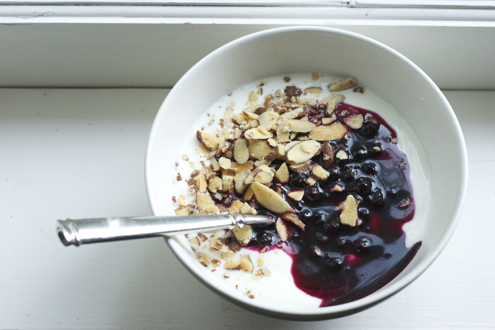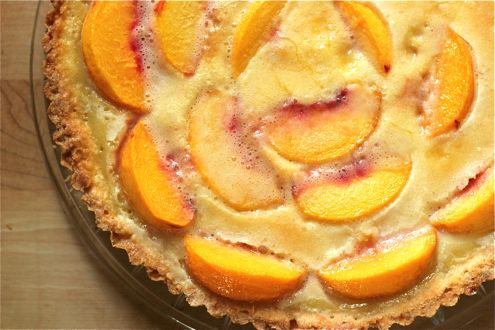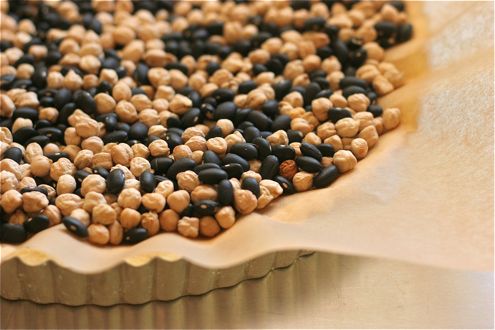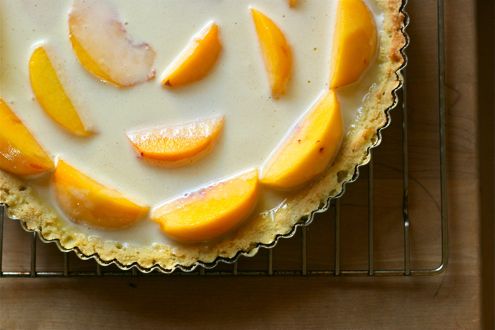This is my idea of the perfect dessert. It is elegant. It is understated. It is not too sweet. It isn’t dependent on the season and yet all kinds of seasonal fruit goes with it and that makes it versatile. From strawberries in June, plums in September, precisely cut little blood orange sections in December to rhubarb compote in March, they all marry beautifully with panna cotta. Plain, it is the essence of pure clean cream. It is ideal for dinner parties of up to 12 people because you must make it in advance so there is no last minute horsing around. Utterly creamy, it is the most beautiful pale ivory color, I am trying to think of a dessert I like better and I can’t. (Well, there is that roasted tangerine tart thing…and the pear custard with chocolate…oh and the fresh strawberry ice cream with brown sugar cookies. Nevermind.) Anyway. Panna Cotta is one of my supreme favorites and I can’t believe I haven’t written about it until now.
The first time I had panna cotta was in a dark cistern of a restaurant in Florence, following a wide soup plate of ribollita. A frutti di bosco puree swirled around the base. That one was good enough to start a bit of an obsession. For the next several years, if I saw panna cotta on the menu, I always ordered it for dessert. Sometimes it was dreamy, barely set, just sweetened cream, served with fruit or a tuile, or sometimes, weirdly, with chocolate. Occasionally there was too much gelatin and that was a disaster! Like rubber. Finally, in a little restaurant in the Mission in San Francisco, after a plate of very tender charred squid and a bowl of boar bolognese and tagliatelle, I had a panna cotta epiphany. Here on a little white plate, was the epitome of the the dessert. It’s highest manifestation. I’m only sort of kidding.
In a puddle of clear caramelized sugar, just burnt enough to be intriguing, a pale quiver of cream. Sections of blood orange were scattered at the edge; their membranes carefully sliced away. Luckily, SFGate published a recipe for the dessert soon after or I would still be pining for it here in Seattle.
I made this panna cotta on Monday for a dinner party I gave my dad as a present. I served it with a blueberry compote scented with lemon. (If you like to cook, it makes a great gift to give someone an entire dinner party. Loads of fun.)
Delfina Buttermilk Panna Cotta
Caramel
- 1 1/4 cups sugar
- Juice of 1/2 lemon
- a little water + 1/4 cup of water
- 1 envelope gelatin (about 1 tablespoon)
- 3 cups whipping cream
- 1 1/4 cups + 2 tablespoons sugar
- 1 cup buttermilk
- Juice of 2 lemons
- To make the caramel: In a small heavy bottomed saucepan, combine the sugar and lemon juice.
- Add just enough water to moisten to a sandy texture.
- Using a pastry brush dipped in water, brush any sugar off the sides of the pot. This will help you avoid crystalizing the sugar. Don’t worry too much about this, I have accidentally crystalized sugar in other recipes, but never in this one.
- Cook over medium- high heat until the sugar caramelizes. The color should be as deep a copper as an old penny. Getting the color right will ensure rich flavor. Just don’t burn it!
- Remove from heat and stand back while you add the 1/4 cup water. Don’t get spattered! The hot caramel will sputter like crazy when you add the water.
- When the sputtering stops, pour the caramel into a dozen little ramekins. Mine are 6 ounce and I got them at IKEA .Carefully tilt the cups to coat with caramel. Set aside.
- To make the custard: Empty the package of gelatin into a small bowl. Stir in 4 tbsp of water and stir. Set aside.
- Add the cream and sugar to a medium heavy bottomed saucepan and whisk. Heat until there are bubbles all around the edges but remove from the heat before it reaches a rolling boil. Stir in the softened gelatin and whisk until it dissolves completely. Add the buttermilk and lemon juice and whisk briefly until combined. Remove from heat and let cool.
- Pour the custard into the ramekins, over the caramel. Refrigerate overnight.
- To unmold: Fill a small baking dish with very hot tap water. Working methodically, slip a small sharp paring knife around the inside of the molds to loosen the custards and set in the hot water for a about 10 seconds. Invert ramekin over a serving plate and whack it gently. It should slide gently onto the plate, surrounded by a pool of caramel.
- Spoon a little blueberry compote around the edge.
Blueberry Compote
- 2 cups blueberries, fresh or frozen if you must
- 1/3-1/2 c. sugar (sometimes frozen berries are very tart)
- grated zest from 1 lemon
- 2 tbsp water (if using fresh berries)
- 1 tsp. cornstarch
- 2 tbsp lemon juice
- Stir the blueberries, sugar, lemon zest and water (if using) in a small saucepan. Heat until liquidy and the blueberries soften.
- In a small bowl, add the cornstarch to the lemon juice and stir until smooth. Scrape into the blueberry mixture. Stir and heat just until the berries reach a boil.
- Cool a little bit before serving. The contrast between the warm berries and the cool panna cotta is pleasing.
I did have panna cotta last week at a sushi place here in Seattle. (Take note – this might be the best sushi I’ve ever had!) Anyway for dessert, they served Panna Cotta with a clear yuzu sauce. Fantastic.





















